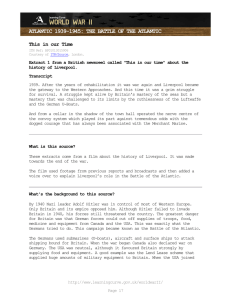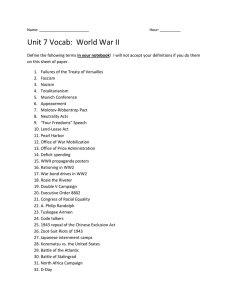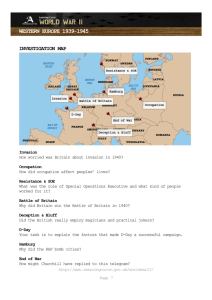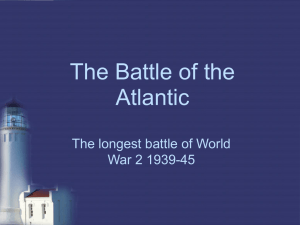ATLANTIC 1939-1945: THE BATTLE OF THE ATLANTIC This in our Time
advertisement
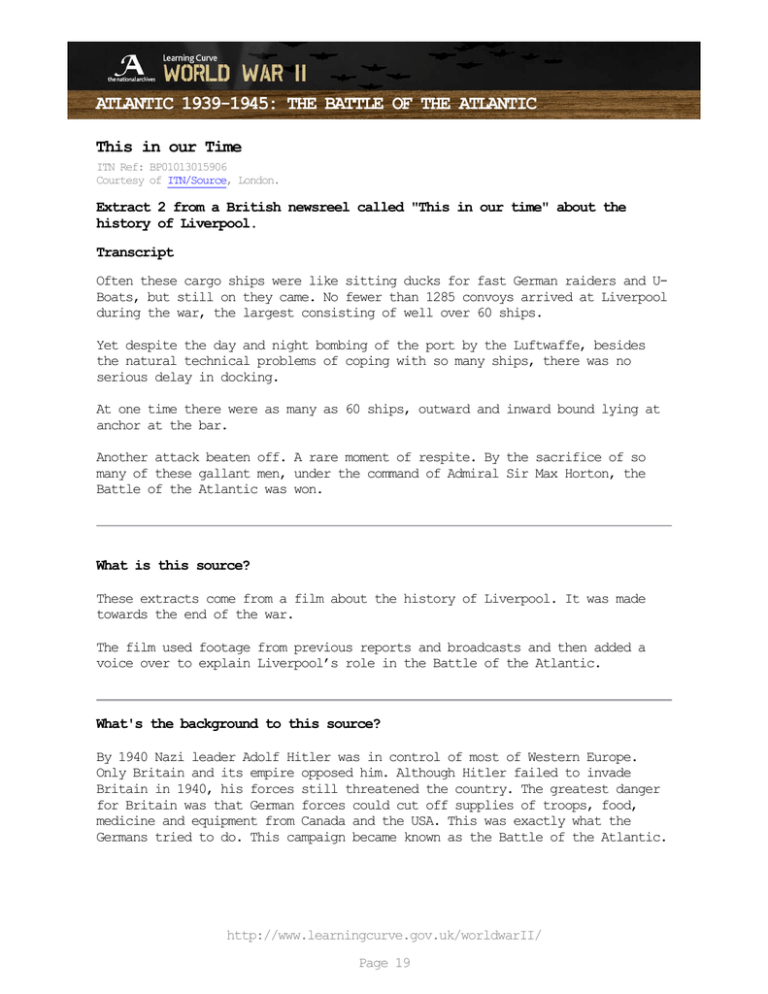
ATLANTIC 1939-1945: THE BATTLE OF THE ATLANTIC This in our Time ITN Ref: BP01013015906 Courtesy of ITN/Source, London. Extract 2 from a British newsreel called "This in our time" about the history of Liverpool. Transcript Often these cargo ships were like sitting ducks for fast German raiders and UBoats, but still on they came. No fewer than 1285 convoys arrived at Liverpool during the war, the largest consisting of well over 60 ships. Yet despite the day and night bombing of the port by the Luftwaffe, besides the natural technical problems of coping with so many ships, there was no serious delay in docking. At one time there were as many as 60 ships, outward and inward bound lying at anchor at the bar. Another attack beaten off. A rare moment of respite. By the sacrifice of so many of these gallant men, under the command of Admiral Sir Max Horton, the Battle of the Atlantic was won. What is this source? These extracts come from a film about the history of Liverpool. It was made towards the end of the war. The film used footage from previous reports and broadcasts and then added a voice over to explain Liverpool’s role in the Battle of the Atlantic. What's the background to this source? By 1940 Nazi leader Adolf Hitler was in control of most of Western Europe. Only Britain and its empire opposed him. Although Hitler failed to invade Britain in 1940, his forces still threatened the country. The greatest danger for Britain was that German forces could cut off supplies of troops, food, medicine and equipment from Canada and the USA. This was exactly what the Germans tried to do. This campaign became known as the Battle of the Atlantic. http://www.learningcurve.gov.uk/worldwarII/ Page 19 ATLANTIC 1939-1945: THE BATTLE OF THE ATLANTIC The Germans used submarines (U-boats), aircraft and surface ships to attack shipping bound for Britain. When the war began Canada also declared war on Germany. The USA was neutral, although it favoured Britain strongly by supplying food and equipment. A good example was the Lend Lease scheme that supplied huge amounts of military equipment to Britain. When the USA joined the war in 1941 the scheme continued, and the US naval forces also took direct action against German forces in the Atlantic. It's worth knowing that... The British headquarters for the Battle of the Atlantic was originally in Plymouth. However, it was vulnerable to air raids and was not a main port for the Atlantic convoys. In 1940 the command centre was moved to an underground bunker in Liverpool. During the war Liverpool handled about one third of Britain’s total imports unloading around four convoys a week. During the war about 4.7 million troops passed through, about 1.2 million of them Americans. How will you use this source? 6. 7. 8. 9. Why was Liverpool the command centre for the Battle of the Atlantic? Is there any evidence that Liverpool handled the pressure of war well? What impression do you get of life for the sailors in the convoys? Would you say this source is more useful than our “starter” source showing the journey of convoy in August 1942 for studying the Battle of the Atlantic? 10. Do these film extracts help you to explain why the Battle of the Atlantic was so significant? Use this report table to help plan your report http://www.learningcurve.gov.uk/worldwarII/ Page 20
